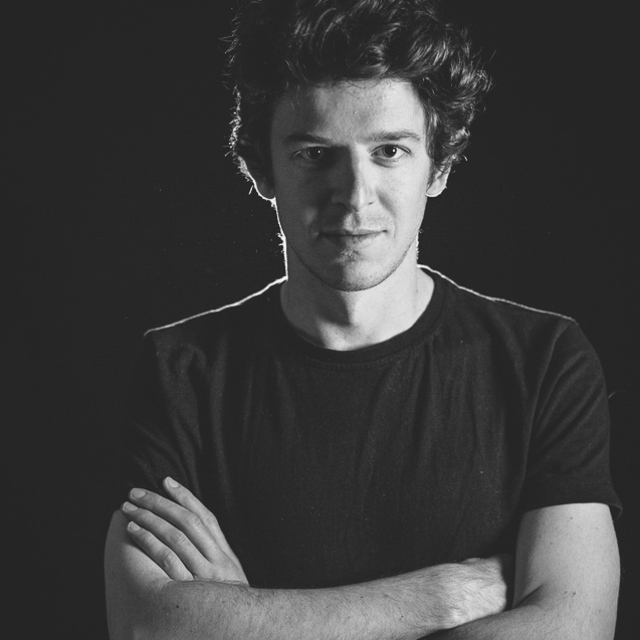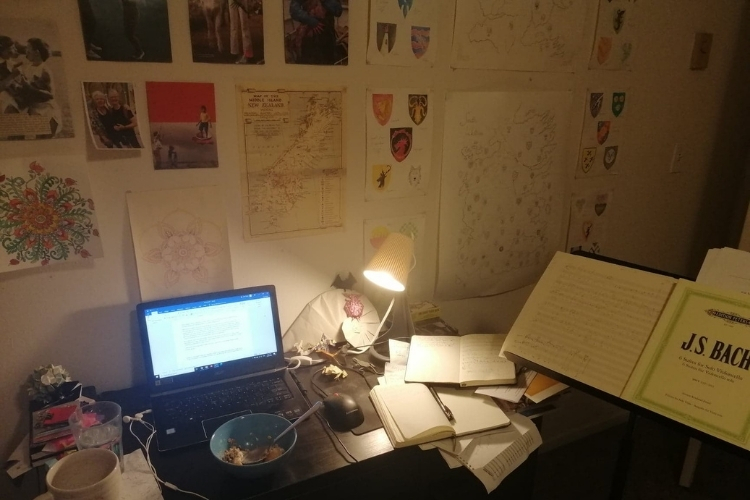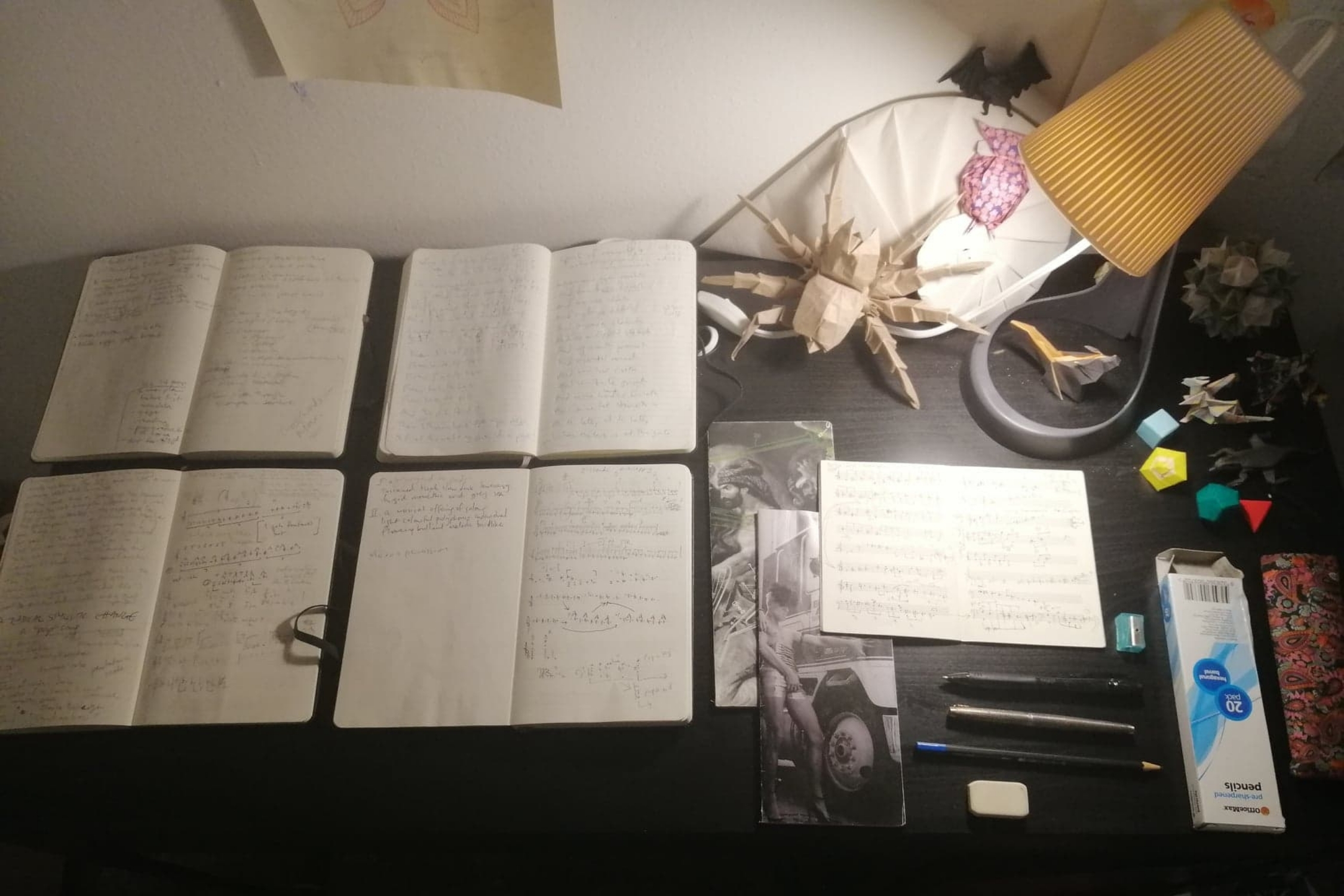In our Composer Spaces series, we ask composers to share a bit about their working environment and to give us a brief insight into their process. This week we present composer Alex Taylor.

My composing tends to come in bursts and clumps; it’s not unusual to have three or four commissions overlapping or in quick succession and then nothing for a while. A typical day might involve no composing whatsoever, depending on what projects I have on the go – but I do love it when I get the chance to just compose every day for several weeks without having to think about other things.
A typical composing day for me usually involves a stretch of activity in the middle of the day – my most productive hours are probably from 10 until 3; the later afternoon is prime lunch/nap/daydream territory, and then there might be another stretch before dinner. It’s unusual for me to work at nighttime unless I’m really under the pump. I’m pretty happy if I can get three or four hours of good composing work done in a day – which doesn’t seem like a lot, but it tends to take up a lot of brain space. I like to think I’m efficient!
 Typical desk clutter – half-eaten breakfast, coffee (NB extra large mug),piles of scrap paper, notebooks, music stand, computer screen, origami detritus, lamp, wall art.
Typical desk clutter – half-eaten breakfast, coffee (NB extra large mug),piles of scrap paper, notebooks, music stand, computer screen, origami detritus, lamp, wall art.
At the moment here in San Diego I have a work desk set up in my bedroom – it’s relatively quiet and less reverberant than the rest of the apartment. Having said that I generally like to have a dedicated office space where I can spread out and strew materials around the place – I’m organized but messy; I’m constantly writing lists or jotting down ideas in notebooks or on random scraps of paper.
In the early stages of a piece, I might spend quite a bit of time outside with a notebook, somewhere with nice light, a park bench or an outside table at a café.
Regardless, I get a lot of inspiration from visual stimuli – colour, shape, texture – so I like to surround myself with interesting viewpoints, objects, messes.
I keep a decent stash of HB pencils and a pad of Carta no. 27 manuscript, but honestly, I’ll use whatever I have on hand; I have several Moleskine manuscript notebooks around and several lined writing notebooks that I’ll often draw staves on if I don’t have manuscript handy. A piece almost always starts off handwritten, although I’ll progress fairly quickly to the computer once I’ve developed some materials. Maybe the quirkiest (and most embarrassing) thing about my composing is that I use an extremely old version of Sibelius that I’ve never bothered to upgrade.
 Some notebooks and writing implements. Origami friends look on.
Some notebooks and writing implements. Origami friends look on.
There’s often a lot of ‘pre-compositional’ work that happens first; writing out different permutations of modes, inversions and transpositions of chords, counting beat patterns, etc. – the development of a language, or maybe more accurately a dialect, for each new piece. A set of possible moves.
Then that material gets filtered through something more personal – a melody, or a particular chord sequence, that gets manipulated and developed according to my particular musical tastes and biases, the idioms of the instruments, the trajectory of the piece.
I’ve been writing a lot of vocal music recently, and that involves spending time with the text. Speaking it aloud, speaking it in my mind’s ear, finding the cadences and patterns of rhythm, trying out different melodies, seeing how it sits in my own voice, imagining how it sits in the singer’s voice I’m writing for.
Right at the moment I’m not writing anything, which is quite nice. The early part of 2020 was extremely busy, with three pieces I was working on basically simultaneously – Poema de La Siguiriya Gitana, a setting of Lorca for tenor, cello and percussion (part of my doctoral studies here at UCSD); The Paihia Piano Party, a music-theatre collaboration with Celeste Oram for the APO’s Beethoven series; and A Handful of False Starts and Dead Ends, an octet for Ensemble Proton Bern utilizing some unusual auxiliary wind instruments (ever heard of a Lupophone?)
Most recently I’ve just finished another vocal work, Sea Gods, a setting of H.D. for mezzo, flute, oboe, percussion, violin, cello and bass. It was slated for performance here in October but it’s likely to be another year before I’ll get to hear it.
I have some interesting projects lined up for the next year, two of which involve New Zealand-based chamber groups – crossing my fingers and toes that I’ll be able to come back home for some premieres in 2021!
A Handful of False Starts and Dead Ends
Poema de La Siguiriya Gitana
